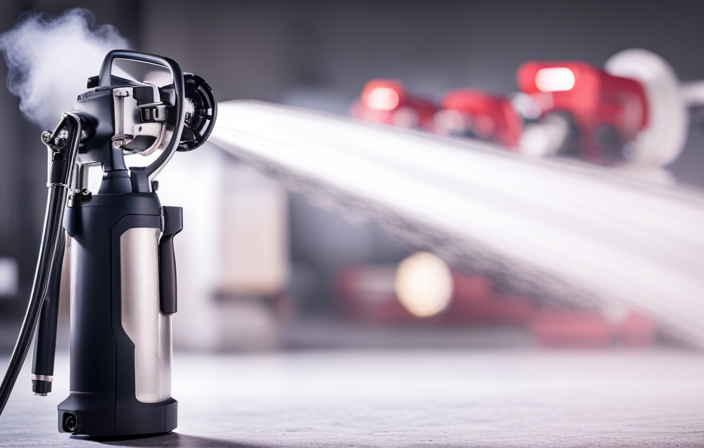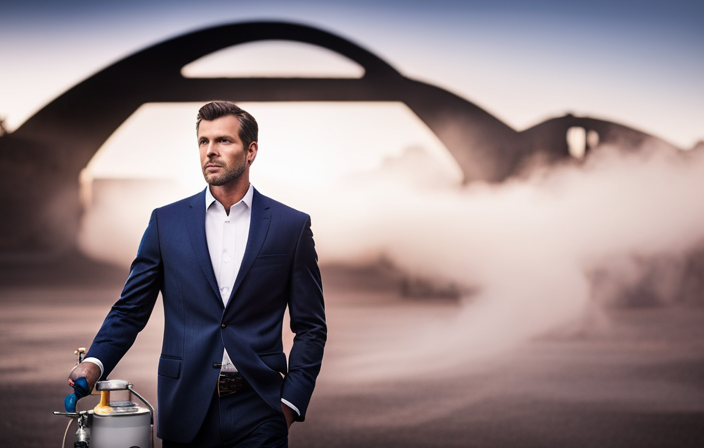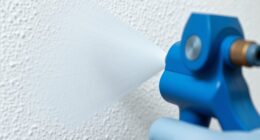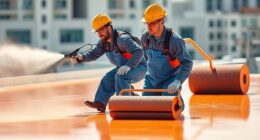As someone who uses airless paint sprayers often, I understand the importance of keeping my equipment in top condition. A key factor in preserving the longevity and effectiveness of these sprayers is using a pump protector solution.
Think of it as a shield that safeguards your sprayer’s pump from damage and ensures smooth operation. But with so many options available, it can be overwhelming to choose the right one.
That’s why I’ve researched and compiled a comprehensive guide to help you make an informed decision. In this article, I will discuss the different types of pump protector solutions, factors to consider when selecting one, and provide step-by-step instructions on how to apply it correctly.
Additionally, I will recommend some highly effective pump protector solutions specifically designed for airless paint sprayers.
So, let’s dive in and learn how to keep our sprayers running like a well-oiled machine!
Key Takeaways
- Pump protector solutions, whether oil-based or water-based, are essential for maintaining the longevity and efficiency of an airless paint sprayer.
- Regular application of pump protector solution helps prevent corrosion, reduces wear and tear, and extends the lifespan of the equipment.
- DIY pump protector solutions, such as mixing water and antifreeze or water and windshield washer fluid, can be cost-effective alternatives.
- Proper maintenance, including regular cleaning, inspection, and troubleshooting, is crucial for optimal performance and to prevent issues with the sprayer.
Importance of Pump Protection for Airless Paint Sprayers
Understanding the importance of pump protection for your airless paint sprayer is crucial to avoid machine damage and frustration. Regular maintenance is essential to keep your sprayer in top condition and prevent expensive repairs. One way to protect your pump is by using a pump protector solution. This solution creates a protective barrier against corrosion, rust, and paint build-up damage. By using a pump protector solution, you can extend your sprayer’s lifespan and ensure optimal performance. It not only protects your investment but also saves you time and money in the long run. Now, let’s explore the different types of pump protector solutions available for your airless paint sprayer.
Types of Pump Protector Solutions Available
When it comes to protecting the pump of an airless paint sprayer, there are different types of solutions available.
One option is oil-based pump protector solutions. These solutions provide excellent lubrication and prevent rust and corrosion.
Another option is water-based pump protector solutions. These solutions are environmentally friendly and easy to clean.
Lastly, silicone-based pump protector solutions offer superior protection against wear and tear, as well as temperature variations.
Oil-Based Pump Protector Solutions
Although it’s commonly believed that oil-based pump protector solutions are the best choice for airless paint sprayers, further research is needed to confirm this theory.
Many DIY enthusiasts prefer oil-based pump protectors due to their numerous benefits. Firstly, oil-based solutions offer excellent lubrication to the pump, reducing friction and wear. This ensures smooth operation and extends the lifespan of the sprayer.
Additionally, oil-based protectors create a protective barrier that prevents corrosion and rust formation, even in harsh environments. They also have a high flash point, making them less likely to ignite during operation. However, it’s important to note that oil-based solutions may leave a residue on the painted surface, so proper cleaning is necessary.
Moving on to water-based pump protector solutions, let’s explore their advantages in the next section.
Water-Based Pump Protector Solutions
Water-based pump protector solutions offer a safer and more eco-friendly alternative for protecting your equipment. They are DIY alternatives that provide effective protection without the use of harmful chemicals.
Here are three alternative options to consider:
-
Anti-Freeze Solution: A mixture of water and non-toxic anti-freeze can be used as a pump protector. This solution prevents freezing and corrosion, ensuring the longevity of your airless paint sprayer.
-
Biodegradable Pump Protector: This type of solution is made from natural ingredients that are safe for the environment. It provides a protective barrier against rust and ensures smooth operation of your equipment.
-
Water-Based Lubricant: Using a water-based lubricant can help reduce friction and wear on the pump components. It provides excellent protection without leaving behind any harmful residues.
Transitioning to the next section, silicone-based pump protector solutions offer additional benefits for airless paint sprayers.
Silicone-Based Pump Protector Solutions
Silicone-based pump protector solutions offer added benefits, ensuring your equipment runs smoothly and efficiently, keeping your investment protected and worry-free. These solutions have several advantages over water-based options. First, silicone-based solutions provide better lubrication, reducing friction and wear on the pump components. Second, they offer superior protection against rust and corrosion, extending the lifespan of your airless paint sprayer. Lastly, these solutions are more resistant to extreme temperatures, making them suitable for both hot and cold weather conditions. However, there are a few disadvantages to consider. Silicone-based solutions tend to be more expensive than water-based ones, and they may leave a residue on the sprayed surface if not properly applied. It is important to carefully weigh these advantages and disadvantages when choosing a pump protector solution. Transitioning into the next section, let’s now discuss the factors to consider when selecting the right pump protector solution for your airless paint sprayer.
Factors to Consider When Choosing a Pump Protector Solution
When choosing a pump protector solution for your airless paint sprayer, there are several important factors to consider.
-
Compatibility with your sprayer: Ensure that the pump protector solution is compatible with your specific airless paint sprayer model. Different sprayers may require different types of solutions.
-
Environmental friendliness: Look for a pump protector solution that is eco-friendly and non-toxic. This will not only protect your pump but also minimize any negative impact on the environment.
-
Longevity: Consider the longevity of the pump protector solution. It should provide long-lasting protection to your pump, preventing any potential damage or corrosion.
-
Ease of use: Choose a solution that is easy to apply and does not require any complicated procedures. This will save you time and effort when maintaining your airless paint sprayer.
-
Cost-effectiveness: Evaluate the cost of the pump protector solution and compare it with the benefits it offers. A cost-effective solution will provide optimal pump protection without breaking the bank.
Considering these factors will help you choose the right pump protector solution for your airless paint sprayer.
Now, let’s delve into how to properly apply a pump protector solution.
How to Properly Apply a Pump Protector Solution
When it comes to properly applying a pump protector solution for an airless paint sprayer, there are several key points to consider.
First, it is crucial to thoroughly clean and prepare the pump before application. This includes removing any paint residue or debris from the system.
Next, applying the pump protector solution should be done carefully and evenly, ensuring complete coverage of all internal components.
Finally, regular maintenance and reapplication of the pump protector solution is essential to keep the pump in optimal condition and extend its lifespan.
Cleaning and Preparing the Pump
To effectively clean and prepare the pump, start by using a suitable solution as a pump protector for your airless paint sprayer. This will extend the life of your equipment and ensure optimal performance. When selecting a pump protector solution, look for one specifically designed for airless paint sprayers and compatible with the type of paint you are using.
Using a pump protector solution has several benefits. It helps dissolve and remove any paint residue that may have accumulated in the pump, preventing clogs and blockages. It also lubricates the pump components, reducing friction and wear. Additionally, it protects against rust and corrosion, extending the lifespan of the pump.
By properly cleaning and preparing the pump with a pump protector solution, you can ensure that your airless paint sprayer operates smoothly and efficiently. Next, I will explain how to apply the pump protector solution to further protect your equipment.
Applying the Pump Protector Solution
Applying the pump protector solution can significantly enhance the lifespan and performance of your equipment, ensuring smooth and efficient operation.
Did you know that using a pump protector solution can reduce the risk of clogs and blockages by up to 75%? This solution acts as a barrier, preventing paint residues from accumulating in the pump and causing damage.
To apply the pump protector, simply follow the manufacturer’s instructions. Usually, it involves pouring the solution into the pump’s inlet or connecting a bottle filled with the protector to the sprayer’s suction tube.
Once applied, the pump protector forms a protective layer on the internal components, safeguarding them from corrosion and extending their durability.
Remember to regularly maintain and reapply the pump protector for continued benefits and optimal functioning of your airless paint sprayer.
Regular Maintenance and Reapplication
Regularly maintaining and reapplying the pump protector ensures that your equipment stays protected and operates smoothly, like a well-oiled machine. Here are the benefits of using a pump protector solution for airless paint sprayers:
-
Prevents corrosion: Regular maintenance with a pump protector solution creates a protective barrier that prevents corrosion, extending the lifespan of your equipment.
-
Improves performance: By lubricating the pump components, the solution reduces friction, allowing for smoother operation and optimal performance.
-
Reduces downtime: Properly maintaining and reapplying the pump protector solution minimizes the risk of clogs or damage, reducing downtime and increasing productivity.
By regularly maintaining and reapplying the pump protector solution, you can ensure the longevity and efficiency of your airless paint sprayer.
Now let’s move on to the next section where we will discuss recommended pump protector solutions for airless paint sprayers.
Recommended Pump Protector Solutions for Airless Paint Sprayers
Using a pump protector solution for your airless paint sprayer is highly recommended. Studies have shown that using a pump protector can extend the lifespan of your sprayer by up to 50%. When it comes to pump protector solutions, you have the option of choosing between oil-based and water-based solutions.
Oil-based solutions provide superior lubrication and are ideal for heavy-duty applications. They offer excellent protection and help to reduce wear and tear on the pump. On the other hand, water-based solutions are environmentally friendly and easy to clean up. They also provide adequate protection against corrosion and maintain optimal performance.
The benefits of using a pump protector solution are numerous. It helps to reduce wear and tear on the pump, preventing damage and costly repairs. It also prevents corrosion, which can occur due to exposure to paint and other chemicals. Additionally, using a pump protector solution ensures that your airless paint sprayer operates efficiently and lasts longer.
To ensure the best results, it is important to regularly apply a pump protector solution to your airless paint sprayer. This will help keep it running smoothly and prevent any potential damage. By following these recommendations, you can maintain the optimal performance of your sprayer and extend its lifespan.
DIY Pump Protector Solutions for Airless Paint Sprayers
For longer-lasting performance and to protect your investment, consider making your own pump guard for your airless paint sprayer. There are several DIY pump protector alternatives that you can try, using natural solutions that are readily available.
One option is to mix equal parts of water and antifreeze, which helps prevent freezing in cold temperatures.
Another alternative is to use a mixture of water and windshield washer fluid, which provides lubrication and protection against corrosion.
Additionally, you can create a pump guard solution by combining water with a small amount of dish soap, which helps to break down any paint residue and keeps the pump running smoothly.
These DIY solutions are cost-effective and easy to make, ensuring that your airless paint sprayer remains in optimal condition.
Now, let’s move on to frequently asked questions about pump protector solutions.
Frequently Asked Questions about Pump Protector Solutions
One common question people have about protecting their investment is how to make their own DIY pump guard using natural ingredients.
There are several benefits of using pump protector solutions for airless paint sprayers. First, they help prevent the buildup of paint residue and debris in the pump, which can extend the lifespan of the equipment.
Second, pump protectors create a protective barrier that helps reduce friction and wear on the pump’s components, ensuring smooth operation.
Third, these solutions can help prevent corrosion and rust, particularly if they contain rust inhibitors.
Lastly, using pump protector solutions can help maintain consistent pressure and spray pattern, resulting in better paint application.
It is recommended to apply pump protector solutions after each use or at least once a month, depending on frequency of use. This will ensure optimal performance and longevity of your airless paint sprayer.
Now, let’s move on to some tips for maintaining your airless paint sprayer.
Tips for Maintaining Your Airless Paint Sprayer
To properly maintain your airless paint sprayer, it’s crucial to regularly clean and inspect its components for any signs of damage or wear.
Cleaning techniques are an essential part of maintenance, and they involve removing any excess paint or debris from the sprayer. This can be done by flushing the system with a cleaning solution or running water through the sprayer.
Additionally, it’s important to troubleshoot any issues that may arise. This can include checking for clogs in the nozzle or hose, ensuring proper pressure settings, and inspecting the filters for any blockages.
By following these cleaning techniques and troubleshooting tips, you can ensure that your airless paint sprayer operates smoothly and efficiently.
In the next section, we will discuss common issues with airless paint sprayers and how pump protector solutions can help maintain their performance.
Common Issues with Airless Paint Sprayers and How Pump Protector Solutions Can Help
Maintaining the optimal performance of your airless paint sprayer requires addressing common issues that can arise and utilizing pump protector solutions as a preventative measure.
Regular maintenance is crucial to ensure the longevity and efficiency of your sprayer. One effective way to protect the pump is by using pump protector solutions. Here are three benefits of using these solutions:
-
Prevents corrosion: Pump protector solutions create a protective barrier that prevents corrosion caused by exposure to paint and other chemicals.
-
Extends lifespan: By reducing wear and tear on the pump, these solutions help extend the lifespan of your airless paint sprayer.
-
Enhances performance: Pump protector solutions keep the pump lubricated, resulting in smoother operation and consistent paint flow.
By regularly using pump protector solutions, you can significantly reduce the risk of common issues and keep your airless paint sprayer in top shape. This ensures that your sprayer continues to deliver exceptional performance and saves you time and money on repairs.
Now let’s move on to the conclusion: keeping your airless paint sprayer in top shape.
Conclusion: Keeping Your Airless Paint Sprayer in Top Shape
To keep your airless paint sprayer in top shape, here are some important steps to follow:
-
Regular cleaning and maintenance are crucial. Cleaning the sprayer after each use helps prevent clogs and buildup that can affect its performance.
-
Using a pump protector solution is highly recommended. This solution acts as a barrier, protecting the pump from corrosion and extending its lifespan.
-
The benefits of using a pump protector solution include preventing damage caused by harsh chemicals or paint residues, reducing the risk of costly repairs, and maintaining consistent spray patterns.
By incorporating these practices into your routine, you can enjoy the longevity and reliability of your airless paint sprayer, and continue to produce stunning results with ease.
Frequently Asked Questions
Can I use water as a pump protector solution for my airless paint sprayer?
Water is not recommended as a pump protector solution for airless paint sprayers. Alternatives like pump protector fluids offer better benefits, such as lubrication, rust prevention, and protection against freezing temperatures, ensuring optimal performance and longevity of the sprayer.
How often should I apply a pump protector solution to my airless paint sprayer?
Applying a pump protector solution to your airless paint sprayer is crucial for its longevity and performance. To choose the right solution, consider factors like compatibility, corrosion protection, and lubrication. Regular application ensures optimum protection and extends the life of your sprayer.
Can pump protector solutions be used on other types of paint sprayers?
Yes, pump protector solutions can be used on other types of paint sprayers. They provide numerous benefits such as preventing corrosion, extending the lifespan of the pump, and improving the overall performance of the sprayer.
Are there any specific safety precautions I should take when applying a pump protector solution?
When applying a pump protector solution, it is important to follow safety measures. Wear appropriate protective equipment, such as gloves and goggles, and ensure proper ventilation. Follow the manufacturer’s instructions and use recommended equipment for application.
Can I make my own pump protector solution using household ingredients?
Yes, you can make your own DIY pump protector solution using household ingredients as an alternative to commercial solutions. There are various recipes available online that typically include water, antifreeze, and lubricating oil.
Conclusion
In conclusion, using a reliable pump protector solution is essential for maintaining the peak performance of your airless paint sprayer. This solution acts as a protective shield for the pump, preventing damage and extending its lifespan. Just like a suit of armor protects a knight, a pump protector solution safeguards your sprayer’s pump. Don’t neglect this crucial step in maintenance! Choose a high-quality pump protector solution and apply it properly to ensure that your airless paint sprayer runs smoothly. It will operate effortlessly, like a well-oiled machine.










